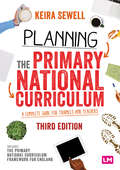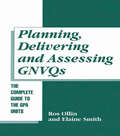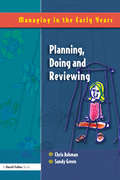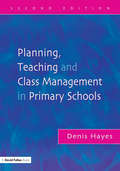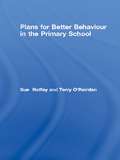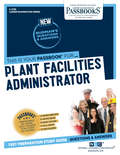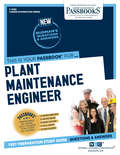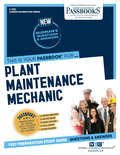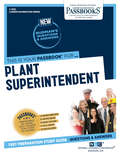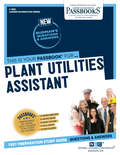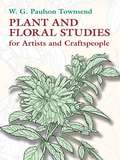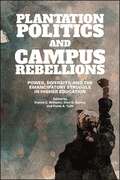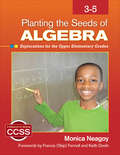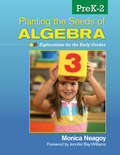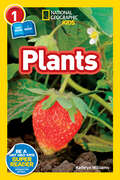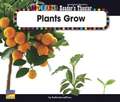- Table View
- List View
Planning the Primary National Curriculum: A complete guide for trainees and teachers (Ready to Teach)
by Keira SewellA complete guide for trainees and teachers To prepare to teach the new Primary National Curriculum, you need more than just the Programmes of Study. You need a resource to help you understand, plan for, teach and assess the curriculum. This is it! Your guide to planning the Primary National Curriculum. This book explores how to plan in primary schools. It covers curriculum design and structure, challenges to learning, and how children learn. New in this edition is a piece on Decolonising the Curriculum. For each curriculum subject the programme of study is included, with notes to help you interpret it for your own class. The text covers how the teaching of each subject can be organised, assessment opportunities, key and essential resources in each subject, and how ICT can best be used in each subject to enhance teaching. Sequenced lesson examples in all subject chapters link theory to practice and highlight progression. The final section of the book explores the many ways in which the curriculum can be delivered. It includes the creative curriculum, dialogic teaching, cross-curricular learning and more current thinking about interpreting the curriculum.
Planning the Primary National Curriculum: A complete guide for trainees and teachers (Ready to Teach)
by Keira SewellA complete guide for trainees and teachers To prepare to teach the Primary National Curriculum, trainee teachers need more than just the Programmes of Study. They need a resource to help them understand, plan for, teach and assess the curriculum. This is their guide to planning the Primary National Curriculum. This book explores how to plan in primary schools. It covers curriculum design and structure, challenges to learning, and how children learn. This 4th edition includes a new chapter on Adaptive Teaching. For each curriculum subject the programme of study is included, with notes to help students interpret it in practice. The text covers how the teaching of each subject can be organised, assessment opportunities, key and essential resources in each subject, and how ICT can best be used in each subject to enhance teaching. Sequenced lesson examples in all subject chapters link theory to practice and highlight progression. The final section of the book explores the many ways in which the curriculum can be delivered. It includes the creative curriculum, dialogic teaching, cross-curricular learning and more current thinking about interpreting the curriculum.
Planning the Primary National Curriculum: A complete guide for trainees and teachers (Ready to Teach)
by Keira SewellA complete guide for trainees and teachers To prepare to teach the Primary National Curriculum, trainee teachers need more than just the Programmes of Study. They need a resource to help them understand, plan for, teach and assess the curriculum. This is their guide to planning the Primary National Curriculum. This book explores how to plan in primary schools. It covers curriculum design and structure, challenges to learning, and how children learn. This 4th edition includes a new chapter on Adaptive Teaching. For each curriculum subject the programme of study is included, with notes to help students interpret it in practice. The text covers how the teaching of each subject can be organised, assessment opportunities, key and essential resources in each subject, and how ICT can best be used in each subject to enhance teaching. Sequenced lesson examples in all subject chapters link theory to practice and highlight progression. The final section of the book explores the many ways in which the curriculum can be delivered. It includes the creative curriculum, dialogic teaching, cross-curricular learning and more current thinking about interpreting the curriculum.
Planning to Teach Writing: A practical guide for primary school teachers
by Emma CaulfieldWritten by an experienced teacher and literacy consultant, Planning to Teach Writing offers an easy-to-use, tried-and-tested framework that will reduce teachers’ planning time while raising standards in writing. Using the circles planning approach, it provides fresh inspiration for teachers who want to engage and enthuse their pupils, with exciting and varied hooks into writing, including picture books, short stories, novels and films.Exploring effective assessment practice, each chapter puts the needs and interests of pupils at the forefront of planning, and models how to design units of work that will lead to high-quality writing outcomes in any primary school classroom. The book uses a simple formula for success: 1 Find the gaps in learning for your students. 2 Choose a hook that you know will engage your students. 3 Select a unit plan that you know will support you to get the best writing out of your students. 4 Tailor it. 5 Teach it! With a fantastic range of hooks to inspire teaching and learning, Planning to Teach Writing ensures successful planning that will maximise engagement, enjoyment and achievement. This book is an accessible and necessary resource for any teacher planning to teach writing in their classroom.
Planning your Academic Publishing Journey: Publish or Perish?
by Jacqui EwartThis book provides a ready reference for academics that covers the breadth of academic publishing. It draws on academic books and journal articles that have touched on various aspects of academic publishing, and on the author’s own extensive experiences, knowledge and lessons. This book explores the processes and decisions related to publishing academic literature such as journal articles, books, and other related formats. This book explores the foundations of an academic publishing career, discusses how to lay those foundations, and how to plan an academic publishing journey. It explores choosing a publisher and publication outlet, authorship, co-authoring, sharing data, dealing with short and lengthy publications, the hidden workload of publishing, and establishing and maintaining an author platform.
Planning, Delivering and Assessing GNVQs: A Practical Guide to Achieving the "G" Units
by Ros Ollin Elaine SmithThis work provides a guide to GNVQ assessor units that teachers must work towards, and is directly linked to the teacher's role in the planning and implementation of GNVQs. It provides examples and case studies across a number of different occupational areas.
Planning, Doing and Reviewing (Managing in the Early Years)
by Green AshmanAs Early Years care and education comes under closer outside scrutiny the number of practitioners moving into managerial roles is constantly increasing, this book focuses on how to make policy work in practice: clarifying the manager’s responsibilities and his or her duty to lead exploring the use of policy and procedures, why we have procedure, how to create procedures and how to put it into practice offering advice on effective planning, how to monitor progress and activity, and tips on feedback and reflection providing links to Ofsted. This is a must-have for students, assessors, nursery nurses with an interest in career development into management and anyone working within a early-years environment in a managerial role.
Planning, Implementing and Evaluating Health Promotion Programs with Navigate Advantage Access
by James F. McKenzie Rosemary Thackeray Brad L NeigerPlanning, Implementing, and Evaluating Health Promotion Programs, Eighth Edition provides students with a comprehensive overview of the practical and theoretical skills needed to plan, implement, and evaluate health promotion programs in a variety of settings. The Eighth Edition incorporates a straightforward, step-by-step format to make concepts clear and the full process of health promotion planning understandable. This edition features updated information throughout, including the most current Responsibilities, Competencies and Subcompetencies (NCHEC & SOPHE, 2020), the Code of Ethics for the Health Education Profession (CNHEO, 2020), a Report of the Joint Committee on Health Education and Promotion Terminology, and a new set of goals and objectives for the nation -- Healthy People 2030. Responsibilities and Competencies Boxes - Readers will find useful boxes that contain the responsibilities and competencies for health education specialists that are applicable to the content of the chapter, and are based on the latest data in the field.Review Questions - The questions at the end of each chapter reinforce the objectives and key terms presented in each chapter and allow readers to test their mastery of chapter content.Activities - Each chapter includes several activities that allow students to use their new knowledge and skills. The activities are presented in several formats, and often build on activities found in earlier chapters.Includes Navigate - Every new print copy includes 365-day access to Navigate Advantage which provides an interactive eBook, flashcards, web links, slides in PowerPoint format, and more. Written for undergraduate courses in Health Education, Promotion, and Planning. A valuable resource to guide students as they prepare to take either the Certified Health Education Specialist (CHES) or Master Certified Health Education Specialist (MCHES) exam. © 2023 | 480 pages
Planning, Instruction, and Assessment: Effective Teaching Practices
by Leslie Grant Jennifer Hindman James StrongeThis entry in the James H. Stronge Research-to-Practice Series focuses on specific strategies teachers can use to improve the quality of their instruction. Studies have shown teacher quality to be the top indicator of student achievement, with the effects of good teachers apparent even as students move on to successive grades. In this book, Grant, Hindman, and Stronge explore the relationship between teacher effectiveness and student learning. They provide a bridge between research-based theories and practical classroom applications. Templates, planning forms, and other reproducibles help teachers make a noticeable impact on student success using proven techniques and practices. Topics include tiered lessons, using assessment data, and much more.
Planning, Teaching and Class Management in Primary Schools, Second Edition
by Denis HayesThis second edition has been fully updated in line with the standards for Qualified Teacher Status (QTS) 202. It will prepare student (trainee) teachers to meet the competencies required for the Teaching Standards. The author looks at *Professional values and practice *Planning and Targets *Monitoring and Assessment *Teaching and Class Management Written in a lucid and engaging style, it offers the reader a well-informed set of insights into the complexities, challenges and opportunities presented by the new requirements. Checklists, diagrams and clearly defined sections for key areas make this book extremely accessible for trainee teachers, class teachers and mentors. It is essential reading for all those who want to clearly understand the ideas behind, and practical application of, the standards.
Plans for Better Behaviour in the Primary School
by Sue Roffey Terry O'ReirdanThis work suggests strategies for working with children who can't settle down to work, who have angry outbursts, who demand constant attention or who display a whole range of challenging behaviours. The book's special format allows the reader to look up the specific type of behaviour and see a range of tactics to help him or her deal with the situation in the short term, and then to consider what might be done in the longer term to prevent recurrence. No more ploughing through dense text - this is all at your fingertips. By drawing on the good practice of many practioners and by looking at the most commonly experienced behavioural difficulties, the authors suggest approaches that really work. This is a behaviour handbook that should appeal to every teacher and teaching assistant and prove a useful resource for learning mentors, behaviour support staff and educational psychologists.
Plant Facilities Administrator: Passbooks Study Guide (Career Examination Series)
by National Learning CorporationThe Plant Facilities Administrator Passbook® prepares you for your test by allowing you to take practice exams in the subjects you need to study. It provides hundreds of questions and answers in the areas that will likely be covered on your upcoming exam.
Plant Maintenance Engineer: Passbooks Study Guide (Career Examination Series)
by National Learning CorporationThe Plant Maintenance Engineer Passbook® prepares you for your test by allowing you to take practice exams in the subjects you need to study. It provides hundreds of questions and answers in the areas that will likely be covered on your upcoming exam, including but not limited to: construction, operation and maintenance of a physical plant, including mechanical and electrical equipment, air conditioning, and heating and ventilating systems; contracts, plans, specifications and estimates; supervision; installation, operation and maintenance of water and sewage plants; and more.
Plant Maintenance Mechanic: Passbooks Study Guide (Career Examination Series)
by National Learning CorporationThe Plant Maintenance Mechanic Passbook® prepares you for your test by allowing you to take practice exams in the subjects you need to study. It provides hundreds of questions and answers in the areas that will likely be covered on your upcoming exam.
Plant Superintendent: Passbooks Study Guide (Career Examination Series #C-2046)
by National Learning CorporationThe Plant Superintendent Passbook® prepares you for your test by allowing you to take practice exams in the subjects you need to study. It provides hundreds of questions and answers in the areas that will likely be covered on your upcoming exam.
Plant Utilities Assistant: Passbooks Study Guide (Career Examination Series)
by National Learning CorporationThe Plant Utilities Assistant Passbook® prepares you for your test by allowing you to take practice exams in the subjects you need to study. It provides hundreds of questions and answers in the areas that will likely be covered on your upcoming exam.
Plant and Floral Studies: for Artists and Craftspeople
by W. G. TownsendRemarkably broad in its applications, this helpful reference covers a wide variety of plants. More than 100 precise drawings of flowers, leaves, buds, and growth patterns are provided for such plants as the anemone, arbutus, broad bean, bell-flower, briar rose, campanula, canterbury bell, dahlia, and lily; a detailed narrative provides descriptions of physical features and general botanical information for each plant.Invaluable for making stencils, needlework canvases, and other floral design projects, this thoroughly illustrated, comprehensive guide will be a boon to amateur and professional artists, art students, and crafters.
Plantation Pedagogy: The Violence of Schooling across Black and Indigenous Space (American Crossroads #72)
by Bayley J. MarquezThroughout the nineteenth and twentieth centuries, teachers, administrators, and policymakers fashioned a system of industrial education that attempted to transform Black and Indigenous peoples and land. This form of teaching—what Bayley J. Marquez names plantation pedagogy—was built on the claim that slavery and land dispossession are fundamentally educational. Plantation pedagogy and the formal institutions that encompassed it were thus integrally tied to enslavement, settlement, and their inherent violence toward land and people. Marquez investigates how proponents developed industrial education domestically and then spread the model abroad as part of US imperialism. A deeply thoughtful and arresting work, Plantation Pedagogy sits where Black and Native studies meet in order to understand our interconnected histories and theorize our collective futures.
Plantation Politics and Campus Rebellions: Power, Diversity, and the Emancipatory Struggle in Higher Education (SUNY series, Critical Race Studies in Education)
by Bianca C. Williams; Dian D. Squire; Frank A. TuittPlantation Politics and Campus Rebellions provides a multidisciplinary exploration of the contemporary university's entanglement with the history of slavery and settler colonialism in the United States. Inspired by more than a hundred student-led protests during the Movement for Black Lives, contributors examine how campus rebellions—and university responses to them—expose the racialized inequities at the core of higher education. Plantation politics are embedded in the everyday workings of universities—in not only the physical structures and spaces of academic institutions, but in its recruitment and attainment strategies, hiring practices, curriculum, and notions of sociality, safety, and community. The book is comprised of three sections that highlight how white supremacy shapes campus communities and classrooms; how current diversity and inclusion initiatives perpetuate inequality; and how students, staff, and faculty practice resistance in the face of institutional and legislative repression. Each chapter interrogates a connection between the academy and the plantation, exploring how Black people and their labor are viewed as simultaneously essential and disruptive to university cultures and economies. The volume is an indispensable read for students, faculty, student affairs professionals, and administrators invested in learning more about how power operates within education and imagining emancipatory futures.
Planting Seeds of the Divine: Torah Commentaries to Cultivate Your Spiritual Practice
by Yiscah SmithExperiencing deep personal fulfillment, happiness, and sustenance comes from feeling connected to our authentic selves, which involves building an ongoing relationship with the Divine Presence within us, says author Yiscah Smith. Quite organically, then, we may begin sensing the Divine in our interactions with other people. This is because, for each of us, &“our essence, as a creation by God, is God.&”Planting Seeds of the Divine elucidates how Judaism&’s sacred texts can provide the foundation for the &“end destination&” of experiencing intimate encounters with the Divine Presence within—the God-consciousness that so many of us find elusive. Imagining ourselves as spiritual gardeners, we can cultivate our unique gardens with seeds centered on middot (emotional dispositions, character traits, spiritual sensitivities). Each seed corresponds to an aspirational Torah commentary, consisting of a selected Torah verse linked to one of the middot, a summary of the biblical text preceding the verse, classical commentaries, teachings of Hasidic and Neo-Hasidic masters and the author, and step-by-step experiential practices to help us internalize the middot and encounter the Divine. Each seed contributes to the garden&’s beauty—the beauty of the self in God-consciousness—which hopefully blossoms into a magnificent garden of the soul.
Planting the Seeds of Algebra, 3-5: Explorations for the Upper Elementary Grades
by Monica M. NeagoyGive your students a foundation of algebra for math success – now and in the future! Algebra is not something to be feared, but something to be embraced with a sense of wonder. Planting the Seeds of Algebra, 3-5, introduces algebra as an accessible way of seeing the world that is necessary to our students’ futures. Students and teachers must become friendly with algebraic foundations, as they have increasingly become the gateway to careers in the STEM fields. Monica Neagoy empowers teachers with theoretical and practical ways to introduce Algebra to 3-5 grade students, making vital connections to concepts they will encounter in middle school and beyond. You’ll discover Four explorations to help you weave key algebraic ideas into everyday mathematics Step-by-step lessons from real classrooms that will guide you in teaching concepts and in establishing their relevance and applicability New teaching methods that break down difficult algebraic concepts and build a critical foundation for higher math Awaken new awareness and change attitudes by sowing the seeds for a vibrant, useful, and rich experience with mathematics. "While reading this book I experienced the sense of wonder and aha moments alongside the students themselves. This book will move your faculty to new depths of understanding about mathematics and will instill the passion to explore a myriad of algebraic concepts." — Bob Weiman, Director St. Stephen’s & St. Agnes School "She’s done it again! Monica Neagoy has authored another book that deftly presents important foundations of algebra while celebrating mathematics through carefully crafted explorations, all of which include student and teacher vignettes and comments about the mathematics they have learned and are teaching. Wow. When I read this book I felt like I was in a classroom!" — Francis (Skip) Fennell, McDaniel College Past President of the National Council of Teachers of Mathematics
Planting the Seeds of Algebra, 3-5: Explorations for the Upper Elementary Grades
by Monica M. NeagoyGive your students a foundation of algebra for math success – now and in the future! Algebra is not something to be feared, but something to be embraced with a sense of wonder. Planting the Seeds of Algebra, 3-5, introduces algebra as an accessible way of seeing the world that is necessary to our students’ futures. Students and teachers must become friendly with algebraic foundations, as they have increasingly become the gateway to careers in the STEM fields. Monica Neagoy empowers teachers with theoretical and practical ways to introduce Algebra to 3-5 grade students, making vital connections to concepts they will encounter in middle school and beyond. You’ll discover Four explorations to help you weave key algebraic ideas into everyday mathematics Step-by-step lessons from real classrooms that will guide you in teaching concepts and in establishing their relevance and applicability New teaching methods that break down difficult algebraic concepts and build a critical foundation for higher math Awaken new awareness and change attitudes by sowing the seeds for a vibrant, useful, and rich experience with mathematics. "While reading this book I experienced the sense of wonder and aha moments alongside the students themselves. This book will move your faculty to new depths of understanding about mathematics and will instill the passion to explore a myriad of algebraic concepts." — Bob Weiman, Director St. Stephen’s & St. Agnes School "She’s done it again! Monica Neagoy has authored another book that deftly presents important foundations of algebra while celebrating mathematics through carefully crafted explorations, all of which include student and teacher vignettes and comments about the mathematics they have learned and are teaching. Wow. When I read this book I felt like I was in a classroom!" — Francis (Skip) Fennell, McDaniel College Past President of the National Council of Teachers of Mathematics
Planting the Seeds of Algebra, PreK–2: Explorations for the Early Grades
by Monica M. NeagoyHelp young minds explore algebraic concepts Algebra is the gateway to higher education, and preparing students to grasp algebraic concepts increases their opportunities to succeed. This book shows teachers how to create a strong foundation in algebra for very young children. Using in-depth math "explorations," the author unpacks—step by step—the hidden connections to higher algebra. Each exploration contains an elegantly simple grade-banded lesson (on addition, subtraction, patterns, and odd and even numbers), followed by a discussion of the algebra connections in the lesson, as well as suggestions for additional problems to explore. Throughout, readers will find: Clear explanations of algebraic connectionsSpecific strategies for teaching the key ideas of algebra Lesson modifications for older or younger studentsAn array of age-appropriate problems, games, and lessons Planting the seeds of Algebra, PreK–2 helps teachers foster mathematical habits of mind in students such as critical thinking, problem solving, adaptability, agility, communication, curiosity, and imagination. Growth in these ways of thinking and doing will transfer to other areas of education and life—raising the bar and challenging students to aspire.
Plants (National Geographic Kids Readers)
by Kathryn WilliamsAdult and child readers will learn all about plants together in this new Co-reader from National Geographic Kids. Find out how plants grow as well as the different parts of plants, seeds, and flowers.
